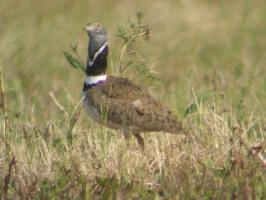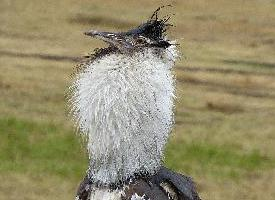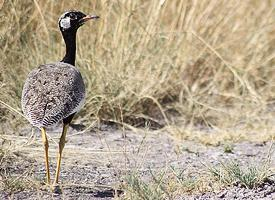
Description de l'animal
The Great Bustard (Otis tarda) is a remarkable bird that belongs to the bustard family, which is known for its large size and impressive appearance. This majestic bird holds the title of being one of the heaviest flying animals in the world. Native to parts of Europe and Asia, with its range extending from the Iberian Peninsula across to northeastern China, the Great Bustard has adapted to a variety of open landscapes, including grasslands, steppes, and agricultural fields.Physically, the Great Bustard is a sight to behold. Adult males are significantly larger than females, with some males weighing up to 16 kilograms (35 pounds) and reaching over a meter (3.3 feet) in height. Their wingspan is also impressive, stretching up to 2.7 meters (8.9 feet), which aids in their powerful yet graceful flight. The plumage of the Great Bustard is predominantly a blend of brown, white, and grey, which serves as excellent camouflage in their natural habitat. Males are distinguishable by their brighter colors and a striking, long white mustache that stands out against a darker head and neck during the breeding season.
Great Bustards lead a gregarious lifestyle outside the breeding season, forming flocks that can number in the hundreds. These birds are omnivores, feeding on a diet that includes insects, small mammals, and a variety of plant materials such as seeds, berries, and shoots. Their feeding habits change with the season, depending on the availability of food sources in their environment.
The breeding season of the Great Bustard is particularly noteworthy. Males perform elaborate and visually spectacular mating displays, known as "lekking," where they puff out their feathers, lower their wings, and throw their heads back to showcase their size and vitality to attract females. This display, combined with specific calls and behaviors, highlights the complexity of their social interactions and mating rituals.
Despite its grandeur, the Great Bustard faces significant threats that have led to a decline in its population. Habitat destruction caused by agricultural expansion, infrastructure development, and changes in land use patterns are primary concerns. Additionally, the Great Bustard suffers from hunting in some parts of its range and collisions with power lines, which pose significant risks to this low-flying species.
Conservation efforts are underway to protect and preserve the Great Bustard populations. These include habitat management and restoration projects, legal protection measures, and initiatives to raise awareness about the species and its plight. Reintroduction programs have also been implemented in areas where the species has become extinct, with some success.
In conclusion, the Great Bustard is an emblematic bird that embodies the beauty and complexity of the natural world. Its unique characteristics, behavior, and the challenges it faces highlight the importance of biodiversity and the need for concerted conservation efforts to ensure that future generations can continue to marvel at this magnificent bird.
Animaux similaires
Nouvelles photos d'animaux
Top 10 des animaux
- Dolphin gull (Leucophaeus scoresbii)
- Diana monkey (Cercopithecus diana)
- Moustached guenon (Cercopithecus cephus)
- Galápagos tortoise (Geochelone nigra complex)
- Russian tortoise (Testudo horsfieldii)
- Japanese macaque (Macaca fuscata)
- Stone loach (Barbatula barbatula)
- Greek tortoise (Testudo graeca)
- Common flying dragon (Draco volans)
- Colossal squid (Mesonychoteuthis hamiltoni)


